India’s vibrant tapestry of traditions, spirituality, festivals, architecture, and landscapes will ignite your memories and stay with you long after you leave its shores.
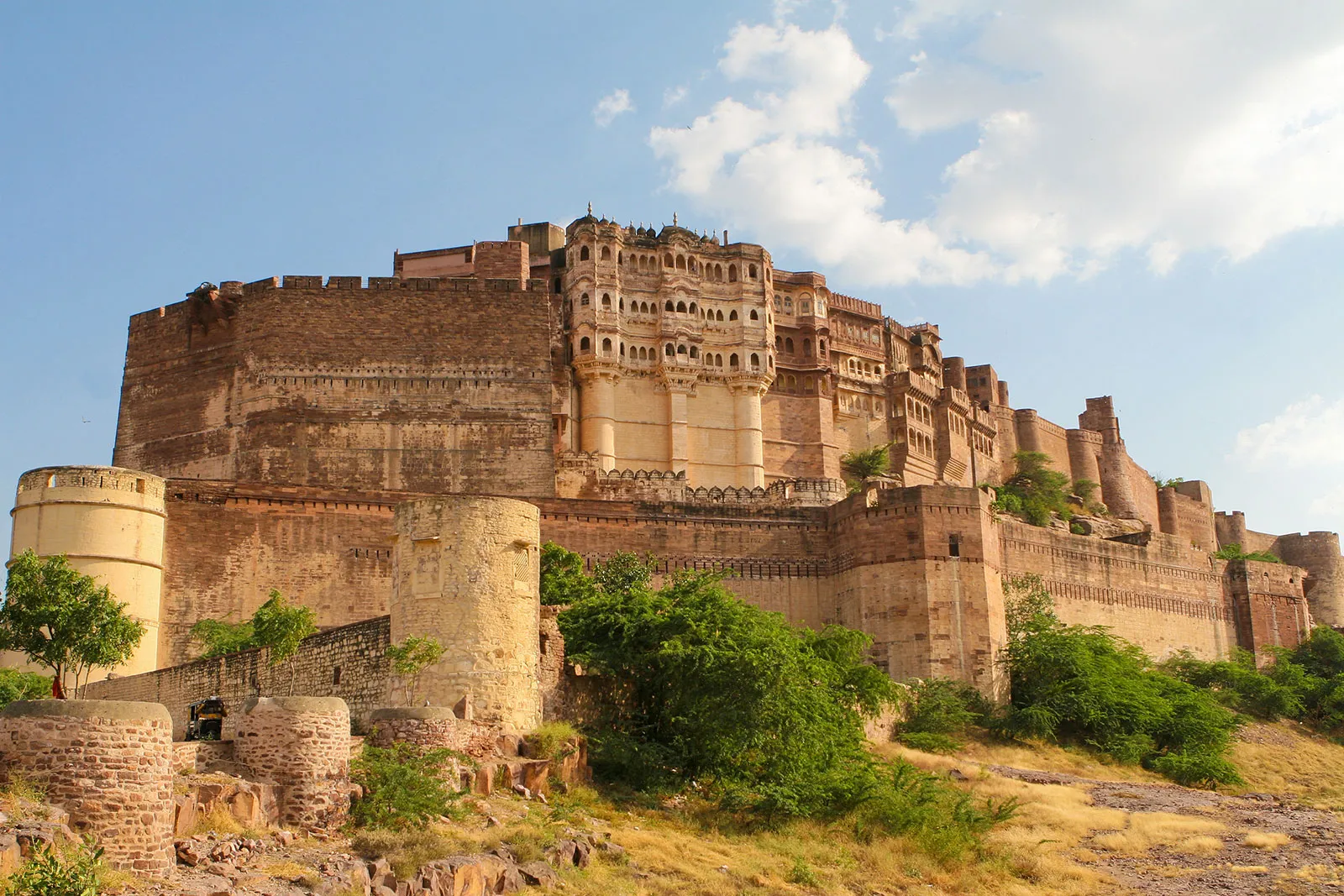
Rising dramatically from a rocky hill that towers 120 meters above Jodhpur’s skyline, Mehrangarh Fort stands as one of India’s most spectacular forts. Its battlements, soaring between 6 and 36 meters high, are seamlessly carved from the very rock beneath it, making the fort appear as though it has grown out of the hillside itself. Mehrangarh is steeped in rich history and legend.
The main entrance is through the northeast gate, Jai Pol, a 300-meter uphill walk from the old city, or a scenic 5-kilometer autorickshaw ride (approximately ₹120). Jai Pol was commissioned by Maharaja Man Singh in 1808 to commemorate his victory over Jaipur’s armies. Beyond the museum ticket office and a small café, you’ll encounter the 16th-century Dodh Kangra Pol, an older gate that still bears the scars of cannonball strikes from 1808.
From there, the main path leads leftward through the 16th-century Imritia Pol and onward to Loha Pol, the original fortified entrance, complete with iron spikes to ward off enemy elephants. Just inside Loha Pol, you’ll find two sets of small handprints—marks left by royal widows who performed sati (ritual self-immolation)—with the last being Maharaja Man Singh’s widows in 1843.
Beyond Loha Pol lies a restaurant and Suraj Pol, which leads into the fort’s museum. After exploring the museum, continue toward the panoramic ramparts, once freely accessible but fenced off in 2016 after a tragic selfie-related accident. The stunning views from here, however, remain unforgettable.
Another path worth exploring begins with a right turn from Jai Pol, winding down to Chokelao Bagh, an enchanting 18th-century Rajput garden lovingly restored. It’s the perfect spot to relax under shady trees with a good book. This path also leads to Fateh Pol, from where you can exit into the charming old city neighborhood of Navchokiya.
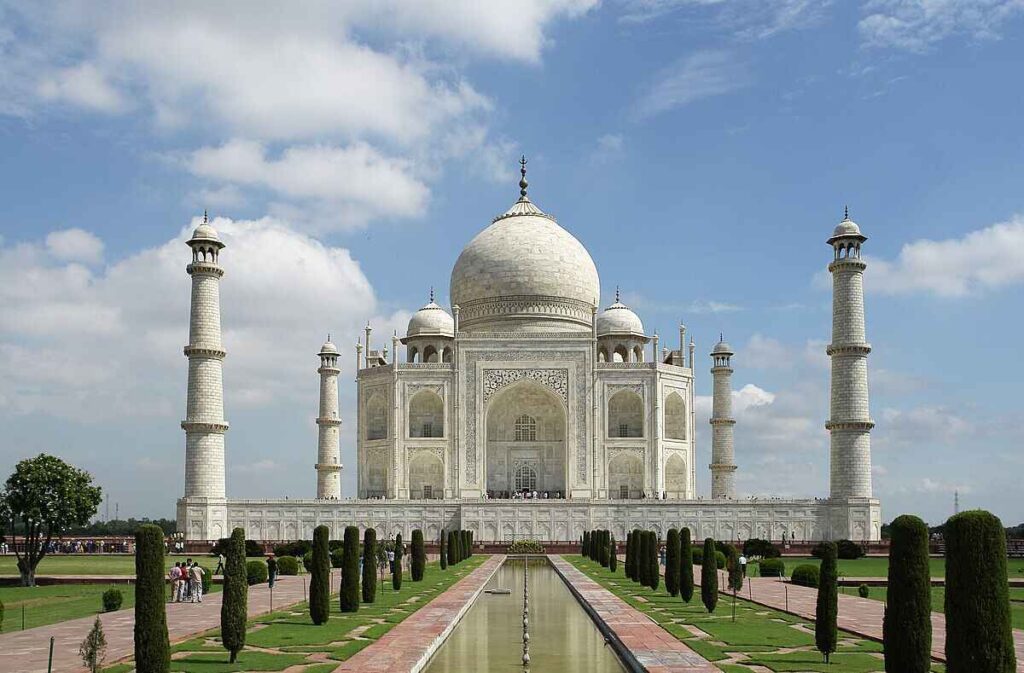
Poet Rabindranath Tagore famously described the Taj Mahal as “a teardrop on the cheek of eternity”, while Rudyard Kipling called it “the embodiment of all things pure”. Its creator, Emperor Shah Jahan, believed it so beautiful that it made “the sun and the moon shed tears from their eyes.” Every year, more visitors than the entire population of Agra pass through its gates to catch a once-in-a-lifetime glimpse of what is widely considered the world’s most beautiful building — and few leave disappointed.
Built as a tribute to his third wife, Mumtaz Mahal, who died giving birth to their 14th child in 1631, the Taj stands as a symbol of Shah Jahan’s profound grief. Legend has it that the emperor’s hair turned grey overnight from sorrow. Construction of the Taj began in 1632; while the main mausoleum was completed in about eight years, the full complex wasn’t finished until 1653. Soon after, Shah Jahan was deposed by his son Aurangzeb and confined to Agra Fort, where he spent his remaining years gazing at the Taj Mahal through a window. After his death in 1666, he was laid to rest beside Mumtaz.
Around 20,000 artisans from across India and Central Asia worked on the Taj, with specialists from Europe contributing to its intricate marble screens and dazzling pietra dura (marble inlay) work using thousands of semiprecious stones.
Designated a World Heritage Site in 1983, the Taj Mahal remains almost as pristine as when it was first built, thanks in part to major restoration efforts in the early 20th century.
Note: The Taj Mahal is closed to visitors on Fridays, except for those attending prayers at the mosque.
Visitors can enter through either the west or east gates (the south gate has been closed for security reasons but can be used for exiting). The east gate usually has shorter queues. Separate lines are maintained for men and women. Foreigners with tickets can skip ahead of local visitor queues — one benefit of the higher ticket price.
Tickets can also be purchased online at https://asi.payumoney.com for a ₹50 discount, although everyone must pass through the same security checks. Access to the inner mausoleum costs an additional ₹200.
Cameras and video recording devices are allowed, but photography inside the mausoleum is prohibited. Tripods are also banned. Each ticket includes a 500ml bottle of water and shoe covers — remember to collect them.
Bags larger than a small money pouch are not allowed inside; free bag storage is provided. Food, tobacco, and pens are confiscated during security screening. Keeping your ticket can earn you a small discount on entry fees for other monuments like Agra Fort, Fatehpur Sikri, Akbar’s Tomb, or the Itimad-ud-Daulah on the same day.
Entering through the east or west gate brings you first to a grand courtyard with a stunning 30m red-sandstone gateway on the southern side.
Beyond it stretch the formal charbagh gardens, divided into four by water channels, featuring a marble plinth at the centre. On still days, the Taj is beautifully mirrored in these waters.
The Taj Mahal itself stands on a raised marble platform at the northern end, its rear facing the Yamuna River. Its elevation ensures a backdrop of only sky — a brilliant architectural decision. At each corner of the platform stands a 40m white marble minaret, slightly tilting outward — a deliberate design meant to protect the main structure during earthquakes.
To the west lies a red-sandstone mosque, a significant place of worship for Agra’s Muslim community. On the east stands the jawab, a symmetrical building designed to balance the composition.
The central building is crafted from semi-translucent white marble, adorned with carved flowers and intricate pietra dura work featuring thousands of semiprecious stones. Each of the four faces showcases monumental vaulted arches decorated with Quranic verses in exquisite inlaid jasper calligraphy. A majestic bulbous dome crowns the structure, surrounded by four smaller domes.
Inside, beneath the main dome, rests the cenotaph of Mumtaz Mahal, encircled by an exquisitely perforated marble screen. Next to it lies the slightly offset cenotaph of Shah Jahan, placed here after his death in 1666 by Aurangzeb. Light filters gently through intricately carved marble screens.
The actual tombs of Mumtaz Mahal and Shah Jahan are located in a chamber directly beneath the main hall.

Often overshadowed by the nearby Taj Mahal, Agra Fort is itself one of the grandest Mughal forts in India. Built by Emperor Akbar in 1565 and later embellished with white marble by Shah Jahan, the fort served as a military stronghold, palace, and later Shah Jahan’s prison after his son Aurangzeb seized power.
Enclosed by massive red-sandstone walls, the fort spans 2.5 kilometers and houses an intricate maze of palaces, mosques, and halls. Entry is via the Amar Singh Gate, originally designed to baffle attackers. Inside, visitors can explore Jehangir’s Palace, the Khas Mahal, Anguri Bagh gardens, and Shah Jahan’s prison tower, the Mathamman Burj, which offers poignant views of the distant Taj Mahal.
Important structures include the Diwan-i-Khas (Hall of Private Audiences), once home to the famed Peacock Throne, and the delicate Nagina Masjid (Gem Mosque) built for royal ladies. The fort still retains a portion under military control and opens 30 minutes before sunrise, with food prohibited inside.
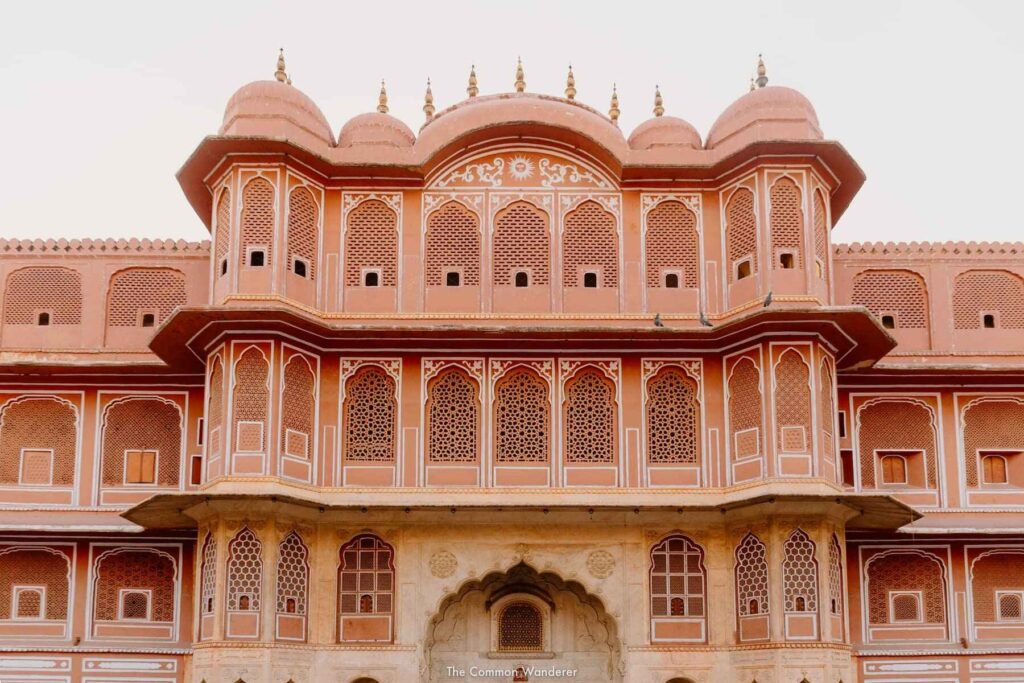
Located at the heart of Jaipur’s Old City, the City Palace is a sprawling complex of courtyards, gardens, and buildings. Originally constructed by Maharaja Jai Singh II, the palace has been expanded and modified over centuries, blending Rajasthani and Mughal architectural styles with some later European influences. Palace structures date from different eras, including some from the early 20th century.
A visit to the City Palace includes a composite ticket that also grants entry to the Royal Gaitor, the Cenotaphs of the Maharanis, and Jaigarh Fort. This ticket is valid for two days and costs Indians an extra ₹60 (at no extra charge for foreign tourists).
Mubarak Mahal
Upon entering through Virendra Pol, visitors first encounter Mubarak Mahal, built in the late 19th century as a reception hall for visiting dignitaries. Designed by Sir Swinton Jacob, it creatively blends Islamic, Rajput, and European elements. Today, it houses the Maharaja Sawai Mansingh II Museum, featuring royal costumes and exquisite Kashmiri pashmina shawls, including the colossal clothing of Sawai Madho Singh I.
The Armoury
Housed within the Anand Mahal Sileg Khana (Maharani’s Palace), the Armoury exhibits one of India’s finest collections of weapons, many ornately inlaid and engraved, showing a fusion of artistry and martial tradition.
Diwan-i-Khas (Sarvatobhadra)
Between the Armoury and the Diwan-i-Am, this open courtyard, paved in pink and white marble, served as the Hall of Private Audience for the maharajas. Here you’ll find two gigantic silver vessels — said to be the largest silver objects in the world.
Diwan-i-Am Art Gallery
Set within the Hall of Public Audience, the gallery features rare exhibits including a tiny, handwritten version of the Bhagavad Gita and other miniature Hindu scriptures, designed to be hidden during times of religious persecution.
Pitam Niwas Chowk & Chandra Mahal
In the inner courtyard, Pitam Niwas Chowk showcases four stunning seasonal gates: the Peacock Gate (autumn), Lotus Gate (summer), Green Gate (spring), and Rose Gate (winter).
Beyond this lies Chandra Mahal, the private residence of the royal descendants. Parts of Chandra Mahal can be visited through the 45-minute Royal Grandeur guided tour.
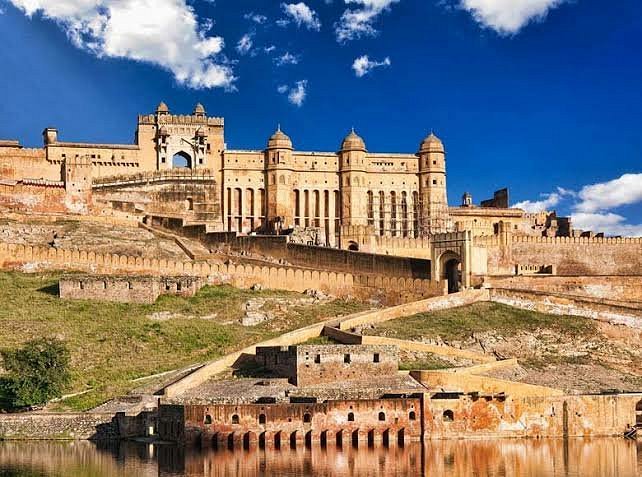
Set atop a rugged hill overlooking Maota Lake, the magnificent Amber Fort is a grand palace complex built from pale yellow and pink sandstone, combined with white marble. The fort is divided into four main sections, each organized around a spacious courtyard.
While it’s possible to reach the fort on elephant-back, concerns about animal welfare have led many visitors to opt for alternatives. You can either walk up from the road in about 10 minutes or hire a 4WD vehicle for ₹450 (good for up to five people), which includes a one-hour wait. For night-time visits, foreign tourists enjoy the same reduced entry price as Indian nationals.
Suraj Pol (Sun Gate)
Most visitors enter through this main gate, arriving at Jaleb Chowk (Main Courtyard), where victorious armies once displayed their spoils. The royal women could watch the celebrations discreetly through veiled palace windows. If arriving by car, you’ll enter through the Chand Pol (Moon Gate).
Siladevi Temple
Just off Jaleb Chowk, a side stairway leads to the small Siladevi Temple, renowned for its stunning silver doors decorated with repoussé work.
Diwan-i-Am (Hall of Public Audience)
Moving up the main staircase brings you to the second courtyard, home to the Diwan-i-Am, with its double rows of columns topped with elephant-shaped capitals and overhead latticed galleries.
Maharaja’s Apartments
In the third courtyard, entered via the beautifully frescoed Ganesh Pol, lie the private quarters of the Maharaja:
Jai Mandir (Hall of Victory) features an extraordinary mirrored ceiling and delicate marble carvings of flowers and cartoon-like insects.
Sukh Niwas (Hall of Pleasure) has an ivory-inlaid sandalwood door and once contained a cooling water channel to combat the desert heat. From Jai Mandir, the ramparts offer stunning views over Maota Lake.
Zenana (Women’s Quarters)
The fourth courtyard houses the secluded women’s quarters. Ingeniously designed corridors allowed the Maharaja to move between the rooms of his wives and concubines unseen by others.
Sound-and-Light Show
Held near Maota Lake below the fort, the show narrates Amber’s rich history, adding a magical dimension to your visit.
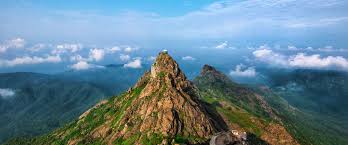
Girnar Hill rises dramatically from the plains and is revered as one of India’s most sacred pilgrimage sites, blending Jain and Hindu traditions. Its rugged beauty and spiritual significance draw countless pilgrims — but reaching its temples is a serious physical challenge.
Climb:
A steep trek of 10,000 stone steps awaits pilgrims, often taking a full day to complete. The journey is demanding but spiritually rewarding.
Starting Point:
The trail begins at Girnar Taleti, 4km east of the city. An autorickshaw ride from town costs about ₹100.
Alternative Transport:
For those unable to walk, dholis (chairs carried by porters) are available:
₹4000 return for passengers between 50kg and 70kg.
₹4500 for heavier passengers (with public weighing if needed).
Refreshments:
Stalls along the route offer snacks and chalk (used by pilgrims to mark their names on the rocks).
Jain Temples:
About two-thirds up the trail, you’ll find a cluster of mosaic-decorated domes and stupas:
Temple of Neminath (12th century): The largest and oldest, dedicated to the 22nd tirthankar. Open all day.
Triple Temple of Mallinath (1177): Dedicated to the ninth tirthankar; a hub during Jain festivals.
Hindu Temples:
Amba Mata Temple: Topping the first peak, popular among newlyweds praying for a happy marriage.
Gorakhnath Temple: Perched on Gujarat’s highest peak (1117m).
Dattatraya Shrine: Located atop the steep peak of Dattatraya, dedicated to the three-faced incarnation of Vishnu.
Kalika Shrine: Atop the final outcrop, dedicated to the fierce goddess Kali.
Note: Photography is allowed on the trail but strictly prohibited inside the temples.
Bhavnath Mela:
Celebrated over five days in the Hindu month of Magha, this festival brings folk music, dancing, and crowds of naga sadhus (naked ascetics) to Bhavnath Mahadev Temple at Girnar Taleti, commemorating Shiva’s cosmic dance of destruction.
A cable car is currently under construction, soon offering pilgrims a faster and easier way to reach the upper temples without the strenuous climb.
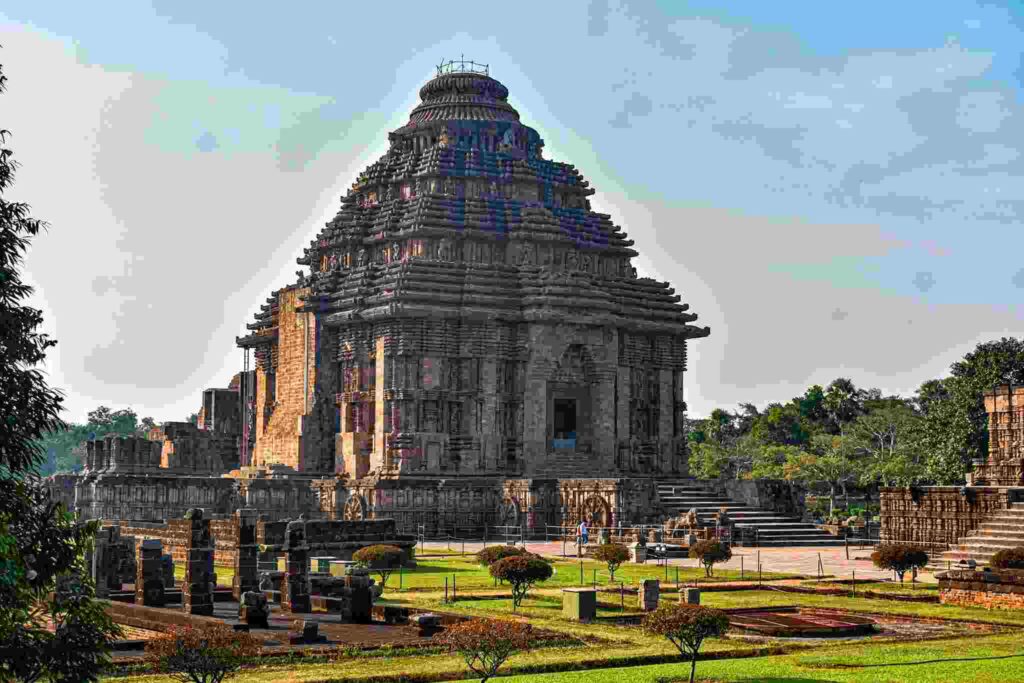
Konark Sun Temple is an extraordinary 13th-century architectural marvel, conceived as the cosmic chariot of Surya, the sun god. It remains one of India’s most iconic and awe-inspiring monuments, rich in symbolism and intricate artistry.
Chariot Structure:
The temple is imagined as a colossal stone chariot:
Seven rearing horses represent the days of the week.
Twenty-four stone cartwheels symbolize the hours of the day.
Solar Alignment:
The temple was precisely positioned so that dawn light would illuminate the sanctum (deul) and the deity within.
Construction:
Built in the mid-13th century, likely by King Narashimhadev I to celebrate a military victory over Muslim forces.
Decline:
The temple was active for about three centuries.
In the late 16th century, the towering 40m-high sikhara (spire) partially collapsed.
Possible causes: Mughal invasions, damage by Kalapahad (a notorious general), or natural cyclones.
Restoration:
The British filled the interior with stone in 1903 to stabilize the ruins.
Ongoing restoration continues today, although modern replacement blocks lack the artistry of the originals.
Main Entrance (Gajasimha):
Guarded by two majestic stone lions crushing elephants.
Nritya Mandapa (Dancing Hall):
Intricately carved and symbolic of the temple’s vibrant artistic life.
Jagamohan (Assembly Hall):
The steps to this hall are flanked by straining horses.
Deul (Sanctuary):
Though spireless today, it houses three stunning chlorite images of Surya, catching light at dawn, noon, and sunset.
Sculptural Narratives:
The temple base and walls showcase Kalinga life — scenes of daily activities, festivities, and sensual erotic art, for which Konark is particularly famous.
Guides:
Persistent but helpful guides are available for ₹150.
Always ensure you hire a government-licensed guide (they will wear official ID badges).
The stone chariot design resonates with other Indian architectural marvels, such as:
The Vittala Temple stone chariot in Hampi.
The Pancha Rathas complex in Mahabalipuram (devoted to the Pandavas of the Mahabharata).
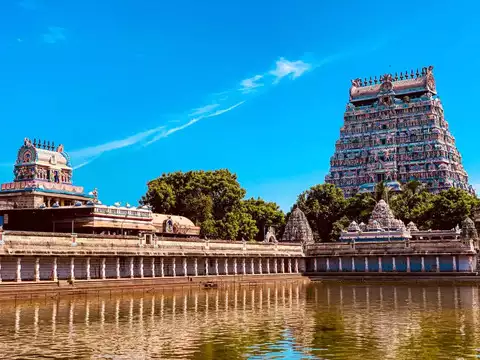
The Meenakshi Amman Temple is the dazzling heart of Madurai and a crowning jewel of South Indian temple architecture, as iconic to the south as the Taj Mahal is to the north.
Deity:
Dedicated to Meenakshi (a form of Parvati) and her consort Sundareswarar (Shiva).
Mythology:
Meenakshi was born with three breasts, with the prophecy that the third would disappear when she met her future husband — which happened upon meeting Shiva.
Architecture:
Sprawls over 6 hectares.
Features 12 soaring gopurams (gateway towers), richly adorned with colorful sculptures of gods, goddesses, demons, and heroes.
The South Gopuram (55m tall) alone has 1511 figures.
Origins:
Dates back over 2000 years, when Madurai was a Pandyan capital.
Current Structure:
Largely rebuilt in the 17th century under Tirumalai Nayak.
Pedestrian-Only Zone:
The streets surrounding the temple are closed to vehicles.
Strict Dress Code:
No exposed shoulders or legs.
No bags or cameras allowed inside.
Atmosphere:
Despite the tight security, the temple feels lively and welcoming, highlighted by vibrant wall and ceiling paintings.
Evening Ceremony (9 PM):
A festive, incense-laden procession carries the icon of Shiva to Meenakshi’s shrine for the night — visitors are welcome to follow along.
Pudhu Mandapa:
A lively shopping area outside the main entrance.
Main Entrance:
Through the eastern gopuram (the oldest one).
Thousand Pillared Hall:
Now houses the Temple Art Museum.
Nandi Shrine:
Surrounded by exquisitely carved pillars.
Shiva Shrine & Meenakshi Shrine:
Central sanctums (restricted to Hindus only).
Golden Lotus Tank:
A sacred water tank surrounded by a small pavilion featuring marriage murals of Meenakshi and Sundareswarar.
Ashta Shakti Mandapa:
Exit hall lined with carvings representing Meenakshi’s eight powers, crowned with a ceiling considered the temple’s most beautiful artwork.
WhatsApp us